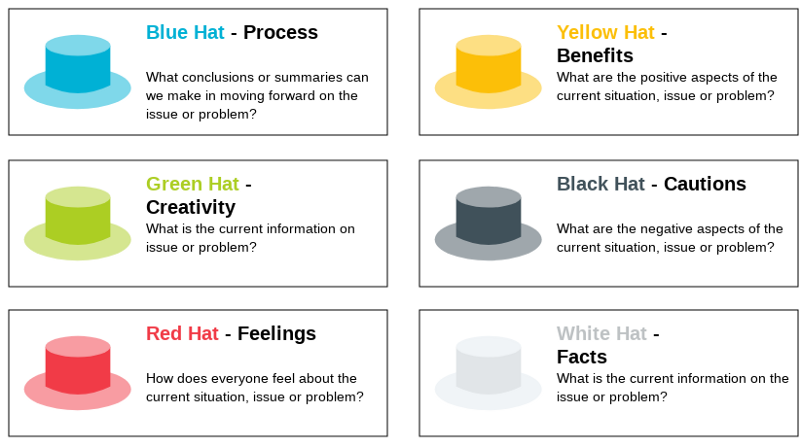Trong một cuộc họp, thường thì mọi người sử dụng các quy trình tư duy khác nhau, điều này có thể khiến cho việc thảo luận có ý nghĩa trở nên khó khăn. Ví dụ, những người thành công thường suy nghĩ từ một góc nhìn rất lý trí và tích cực. Tương tự, những người bi quan có thể quá phòng thủ, và những người cảm xúc hơn có thể không nhìn nhận các quyết định một cách bình tĩnh và lý trí.
Chiếc kỹ thuật sáu chiếc mũ tư duy, được Edward de Bono đề xuất vào năm 1999, khuyến khích một nhóm tiếp cận vấn đề hiện tại từ nhiều góc độ khác nhau. Điều này buộc nhóm phải ra ngoài phong cách tư duy quen thuộc của họ, và giúp họ có cái nhìn toàn diện hơn về một tình huống. Đây là một kỹ thuật quan trọng và mạnh mẽ để tranh luận về một vấn đề, giải quyết một vấn đề hoặc đưa ra một quyết định quan trọng.

Chỉnh sửa ví dụ trên trực tuyến
Cách thực hiện quy trình Sáu Chiếc Mũ Tư Duy?
Trong sáu chiếc mũ tư duy, mọi người cùng suy nghĩ về những vấn đề giống nhau vào cùng một thời điểm, bằng cách đội sáu chiếc mũ ẩn dụ khác nhau. Mỗi chiếc mũ có một màu sắc khác nhau và đại diện cho một loại quy trình tư duy cụ thể.
Trong các cuộc họp, nó có lợi ích là ngăn chặn những cuộc đối đầu xảy ra khi những người có phong cách tư duy khác nhau thảo luận về cùng một vấn đề. Mỗi ‘Chiếc Mũ Tư Duy’ là một phong cách tư duy khác nhau. Những điều này được giải thích dưới đây:
Sáu Chiếc Mũ Tư Duy đã được thiết kế đặc biệt để mọi người suy nghĩ song song chỉ sử dụng một chiếc mũ tại một thời điểm. Quy trình hoạt động tốt nhất với một giới hạn thời gian (tối đa 5 phút) cho mỗi chiếc mũ. Điều này khuyến khích nhóm ‘thử đội những chiếc mũ khác’ và đặc biệt giúp những người có quan điểm rất cố định xem xét ý tưởng từ những góc độ khác nhau.
Mũ Trắng — Sự Thật và Thông Tin
Điều này bao gồm các sự thật, số liệu, nhu cầu thông tin và những khoảng trống. Nó xem xét những gì đã biết và thông tin nào có thể bị thiếu. Sự liên kết là với giấy, nơi mà ‘sự thật’ được ghi lại.
Mũ Đỏ — Cảm Xúc và Trực Giác
Điều này bao gồm trực giác, cảm xúc và tâm trạng. Nó tập trung vào những gì mọi người cảm nhận về vấn đề đang thảo luận. Quan trọng là, không cần phải lý giải hay giải thích.
Mũ Đen — Cảnh Giác và Vấn Đề
Đây là chiếc mũ của sự phán xét và cảnh giác. Đây là chiếc mũ có giá trị nhất. Tâm điểm ở đây là những vấn đề, rủi ro và thách thức mà ý tưởng này có thể gây ra.
Mũ Vàng — Lợi Ích và Ưu Điểm
Đây là điều tích cực hợp lý — tại sao một cái gì đó sẽ hoạt động và tại sao nó sẽ mang lại lợi ích. Nó có thể được sử dụng để mong đợi kết quả của một số hành động được đề xuất, nhưng cũng có thể được sử dụng để tìm kiếm điều gì đó có giá trị trong những gì đã xảy ra.
Mũ Xanh — Quản Lý Tư Duy
Đây là chiếc mũ tổng quan hoặc kiểm soát quy trình. Bạn có thể tóm tắt những phát hiện cho đến nay không? Điều gì cần xảy ra tiếp theo?
Mũ Xanh Lá — Sáng Tạo và Giải Pháp
Đây là chiếc mũ của sự sáng tạo, các lựa chọn, đề xuất, những gì thú vị, khiêu khích và thay đổi. Chiếc mũ này thường được sử dụng trong một buổi động não để tạo ra ý tưởng.
Mẫu Sáu Chiếc Mũ Tư Duy — Phong Cách Sơ Đồ Khái Niệm

Một Mẫu Sáu Chiếc Mũ Tư Duy Khác

Chỉnh sửa ví dụ trên trực tuyến
Mẫu Mô Hình Sáu Chiếc Mũ Tư Duy

This post is also available in Deutsch, English, Español, فارسی, Français, Bahasa Indonesia, 日本語, Polski, Portuguese, Ру́сский, 简体中文 and 繁體中文.













